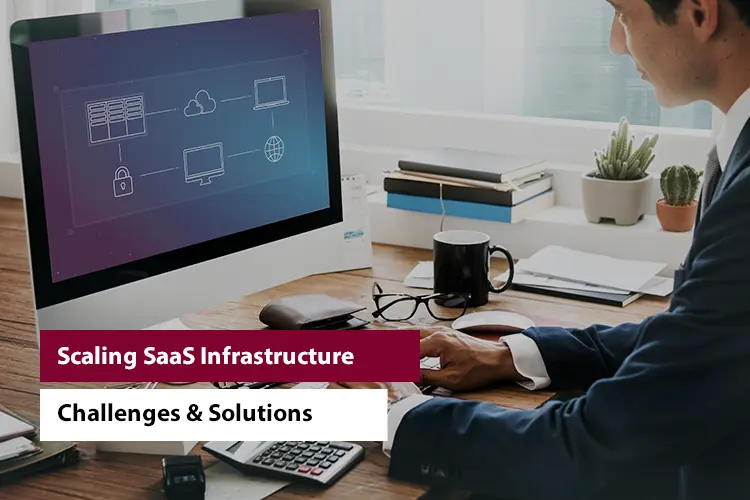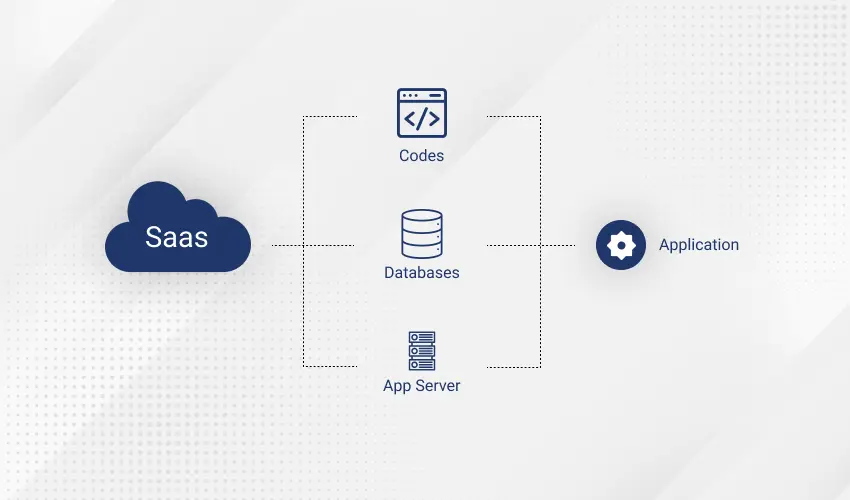Scaling SaaS Infrastructure: Challenges & Solutions

In today’s fast-paced digital landscape, Software as a Service (SaaS) has emerged as a dominant model for delivering software applications over the Internet. SaaS offers numerous benefits such as cost-efficiency, accessibility, and automatic updates, making it a preferred choice for businesses of all sizes. However, as SaaS platforms gain popularity and user bases expand rapidly, the challenge of scaling their infrastructure becomes increasingly crucial. In this blog, we will delve into the challenges faced when scaling SaaS infrastructure and explore potential software solutions to address them.
Understanding SaaS Infrastructure

Understanding the intricacies of SaaS (Software as a Service) infrastructure is essential for anyone involved in building, managing, or utilizing SaaS applications. SaaS has revolutionized the way software is delivered and accessed, transforming traditional software models into cloud-based solutions that offer numerous advantages. To grasp the concept of SaaS infrastructure, let’s delve deeper into its layers and components:
1. Application Layer
The application layer is the user-facing part of the SaaS platform. It comprises the graphical user interface (GUI) that users interact with through web browsers or mobile apps. This layer is responsible for delivering a seamless and intuitive user experience, facilitating actions such as creating accounts, managing settings, and accessing the software’s functionalities.
2. Business Logic Layer
Sitting beneath the application layer is the business logic layer. This layer is the brains of the operation, where the core functionalities and operations of the SaaS application are executed. It processes user requests, enforces business rules, handles data manipulation, and orchestrates interactions between different components. Here, the software’s specific features, algorithms, and workflows are coded and executed.
3. Database Layer
The database layer is where the application’s data is stored, managed, and retrieved. It is the repository for user information, application state, configuration settings, and more. Databases play a crucial role in SaaS infrastructure, as they need to handle increasing volumes of data, support concurrent user requests, and maintain data integrity and security.
4. Infrastructure Layer
The infrastructure layer is the foundation that supports the entire SaaS ecosystem. It encompasses the physical and virtual resources necessary for the platform’s operation. This includes servers, networking components, storage devices, load balancers, firewalls, and more. The infrastructure layer ensures that the application and its various components are accessible, reliable, and secure.
Scaling SaaS Infrastructure
Scaling SaaS infrastructure is a critical endeavor that involves expanding the underlying resources and architecture of a Software as a Service (SaaS) platform to accommodate increased user demand, data volume, and application complexity. As a SaaS platform gains popularity and attracts a larger user base, it must be equipped to handle the accompanying surge in traffic and usage. This process of scaling is essential to maintain the performance, reliability, and user satisfaction that are integral to the success of any SaaS offering. Let’s explore the various dimensions of scaling SaaS infrastructure and the strategies employed to overcome associated challenges:
1. Vertical Scaling (Scaling Up)
Vertical scaling involves enhancing the capabilities of existing infrastructure components, such as upgrading CPU, memory, or storage capacity on a single server. This approach is suitable for addressing short-term performance issues, but it has inherent limitations. There is a threshold beyond which further upgrades become impractical or cost-prohibitive.
2. Horizontal Scaling (Scaling Out)
Horizontal scaling entails adding more instances of servers or resources to the infrastructure to distribute the load. This approach offers better scalability since it leverages a distributed architecture to manage increased traffic and data volume. Horizontal scaling also enhances redundancy and fault tolerance. This can be achieved through load balancers that evenly distribute incoming traffic among multiple servers.
Also read our blog: SaaS vs. PaaS vs. IaaS: Which Cloud Computing Model is Right for Your Business?
Challenges in Scaling SaaS Infrastructure

Scaling SaaS infrastructure brings about a set of complex challenges that require careful consideration and innovative solutions. As a Software as a Service (SaaS) platform grows, the underlying infrastructure must adapt to handle increased demand, data volume, and user expectations. Let’s delve deeper into the challenges that arise during the process of scaling SaaS infrastructure and explore potential solutions to overcome them:
1. Performance Bottlenecks
Challenge: As user traffic and data volume surge, performance bottlenecks can emerge, leading to slow response times, application crashes, and degraded user experiences.
Solution: Implement load balancing mechanisms to evenly distribute incoming traffic among multiple servers. Optimize application code to reduce processing times. Employ content delivery networks (CDNs) to serve static assets and alleviate server load.
2. Database Scalability
Challenge: Traditional relational databases may struggle to manage the increased read and write operations generated by a growing user base and expanding datasets.
Solution: Consider adopting NoSQL databases like MongoDB or Cassandra for horizontal scalability. Utilize database sharding to distribute data across multiple instances. Implement caching strategies to reduce the load on the database.
3. High Availability and Redundancy
Challenge: As user reliance on the SaaS application increases, downtime becomes increasingly unacceptable. Maintaining high availability across various geographic regions is crucial.
Solution: Set up multiple data centers in different regions to ensure redundancy. Implement failover mechanisms that automatically switch to backup servers in case of failure. Utilize cloud services with built-in high availability features.
4. Data Security and Compliance
Challenge: With a larger user base comes a greater responsibility to safeguard sensitive user data. Compliance with data protection regulations becomes more complex.
Solution: Implement end-to-end encryption for data at rest and in transit. Regularly conduct security audits and vulnerability assessments. Utilize identity and access management tools to control data access. Implement granular permissions and encryption keys management.
5. Cost Management
Challenge: Scaling infrastructure can lead to increased costs. Over-provisioning can waste resources, while under-provisioning can impact performance.
Solution: Implement robust monitoring and resource tracking to identify underutilized resources. Leverage cloud services that offer dynamic scaling to adjust resources based on demand. Utilize serverless computing to optimize resource allocation and reduce costs.
6. Maintaining Development Velocity
Challenge: Balancing infrastructure improvements with feature development can slow down development velocity, affecting the speed of delivering new features to users.
Solution: Implement continuous integration and continuous deployment (CI/CD) pipelines to automate testing and deployment processes. Adopt microservices architecture to develop, deploy, and scale individual features independently.
7. Monitoring and Management
Challenge: With a larger and more complex infrastructure, monitoring and managing the various components become increasingly challenging.
Solution: Implement robust monitoring and alerting systems to proactively identify and address issues. Utilize centralized logging and monitoring tools to gain insights into the entire system’s performance and health.
Also Read Our Page : hire offshore developers
The Best Practices for Scaling the SaaS Infrastructure

Scaling SaaS infrastructure is a multifaceted and intricate process that demands careful consideration, strategic planning, and the application of well-defined best practices to ensure seamless growth and optimal performance. As your user base continues to expand and evolve, following these informative best practices can help you effectively navigate the complexities of scaling, while maintaining a high level of service quality and user satisfaction.
1. Thoroughly Assess Your Infrastructure
Commence your scaling journey with a comprehensive evaluation of your existing infrastructure. Gain a deep understanding of its current strengths, vulnerabilities, and potential bottlenecks. This insightful assessment will serve as the bedrock for your informed scaling strategy.
2. Prioritize Horizontal Scalability
While scaling options abound, prioritize the merits of horizontal scalability. This strategy involves adding more instances of servers or resources to distribute the load evenly. This approach not only accommodates increased user demand but also fortifies redundancy to bolster system reliability.
3. Harness the Power of Cloud Services
Capitalizing on the capabilities of cloud platforms, such as AWS, Azure, or Google Cloud, is pivotal in achieving seamless scalability. Embrace auto-scaling features that empower your infrastructure to dynamically adjust resources in real-time according to prevailing traffic patterns.
4. Embrace the Agility of Microservices Architecture
Embracing a microservices architecture has emerged as a transformative approach to scaling. By decomposing your application into smaller, autonomous components, you streamline development, facilitate independent deployment, and enable more efficient scaling, thereby fostering greater agility.
5. Implement Strategic Load Balancing
A robust load balancing strategy is paramount for a well-scaled infrastructure. By deploying load balancers, you can judiciously distribute incoming traffic across multiple servers. This not only ensures optimal resource utilization but also prevents individual servers from becoming overwhelmed.
6. Elevate Database Performance
Elevating database performance becomes crucial as data volumes escalate. Choose databases that align with your scalability prerequisites. Integrate advanced techniques like sharding, replication, and caching to fine-tune database operations and maintain responsiveness.
7. Vigilant Monitoring and Analytical Insight
Deploying vigilant monitoring and advanced alerting systems empowers you to maintain a comprehensive overview of resource utilization, application performance, and potential anomalies. This proactive approach enables swift intervention to mitigate service disruptions.
8. Automate Deployment Processes with CI/CD
Embrace the efficiency of continuous integration and continuous deployment (CI/CD) pipelines. This automation accelerates testing and deployment workflows, facilitating the seamless release of updates while minimizing any associated downtime.
9. Elevate Security Measures in Tandem
As your infrastructure expands, security measures must rise to the occasion. Conduct regular security audits, integrate robust encryption protocols, enforce stringent access controls, and remain abreast of the latest security best practices to ensure comprehensive protection.
10. Explore the Benefits of Serverless Architecture
Delve into the realm of serverless architecture, a paradigm that abstracts server management. This model optimizes resource utilization, charges based on actual usage, and significantly reduces operational complexities.
11. Plan for Eventualities and Swift Recovery
Design your infrastructure with meticulous attention to redundancy, failover mechanisms, and comprehensive disaster recovery plans. This resilient setup ensures minimal downtime and swift recovery in the face of unforeseen events.
12. Rigorously Test at Scale
Regularly conduct exhaustive load testing and performance assessments to simulate real-world usage scenarios. This practice serves as a proactive measure to identify performance bottlenecks and vulnerabilities before they impact users.
13. Optimize Resource Allocation Continuously
Sustained resource optimization is essential. Regularly analyze resource allocation patterns and make judicious adjustments. This meticulous practice ensures resources are efficiently utilized while preventing both underutilization and overprovisioning.
14. Proactively Scale to Anticipate Demand Spikes
Stay ahead of demand surges by proactively scaling your infrastructure. Leverage insights from historical data and future projections to allocate resources in advance, ensuring uninterrupted and optimal performance.
15. Document, Learn, and Iteratively Refine
Documenting your scaling journey, along with the decisions made, challenges faced, and victories achieved, becomes invaluable. Regularly revisit and refine your approach based on new insights, lessons learned, and evolving business dynamics.
Conclusion
Scaling SaaS infrastructure presents a multifaceted set of challenges that demand careful planning, innovative strategies, and a holistic approach. By addressing performance bottlenecks, ensuring database scalability, maintaining high availability, enhancing data security and compliance, managing costs, maintaining development velocity, and implementing effective monitoring and management practices, SaaS providers can successfully navigate the complexities of scaling and offer users a seamless, secure, and reliable experience. It’s through tackling these challenges head-on that SaaS platforms can continue to evolve, adapt, and thrive in an ever-changing technological landscape.
If you’re looking for a partner to help you navigate these challenges and scale your SaaS infrastructure with expertise, consider exploring the solutions offered by Imenso Software. Their proven track record in crafting efficient and scalable SaaS solutions can empower your platform for growth.
We’re honored to mention that our efforts have been recognized by renowned B2B review and research platforms such as GoodFirms, Clutch, MirrorView, and many more.
Want more information about our services?
Similar Posts

Average Time to Build a Website from Scratch in 2023
Whatever the field, a company’s online presence has a big impact on how successful it is. Many businesses still seem to be neglecting the fact that the majority of their customers tend to visit their websites before making a purchase. A strong online presence, particularly a website, can be crucial for increasing revenue. If your […]...

Top 10 Features of Power BI for Creating Powerful Data Visualizations
Are you ready to unleash the hidden potential of your business data? In today’s data-driven world, the ability to extract meaningful insights and transform them into actionable strategies is the key to staying ahead of the competition. But with vast amounts of data at our fingertips, how can we efficiently navigate through the sea of […]...

Top PHP Development Tools Every Developer Should Explore
PHP an acronym for Hypertext Preprocessor is without a shadow of a doubt one of the most popular open-source scripting languages. It is not only easy to use, but it’s development tools offer speed and ease that transcends any other programming language....






